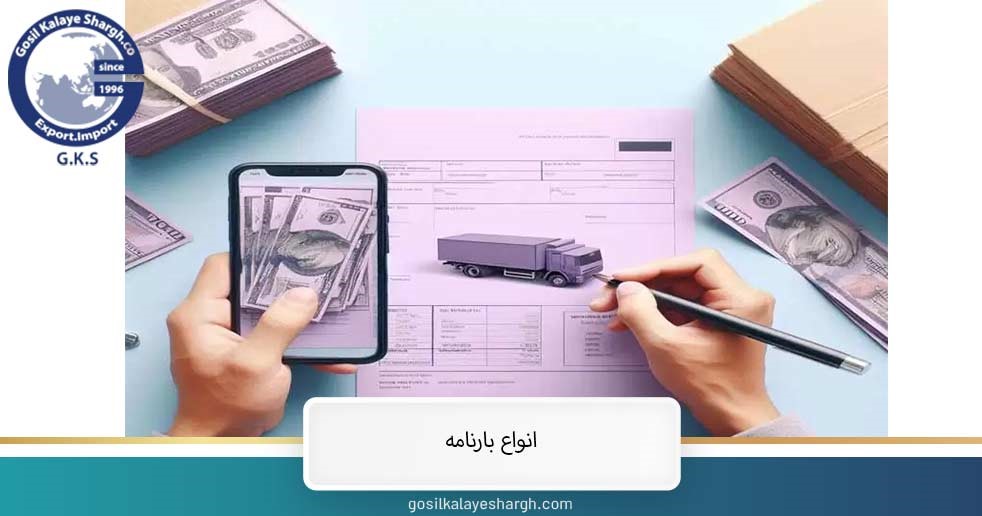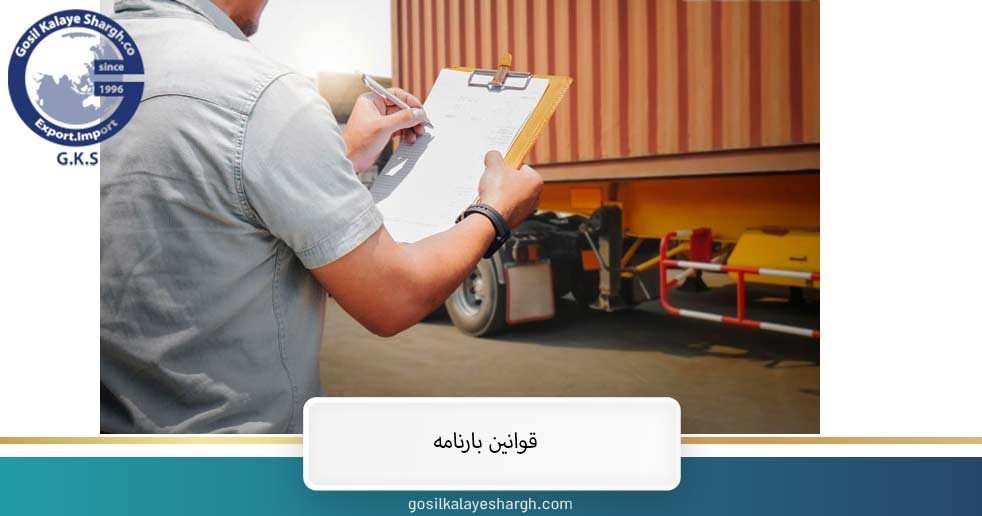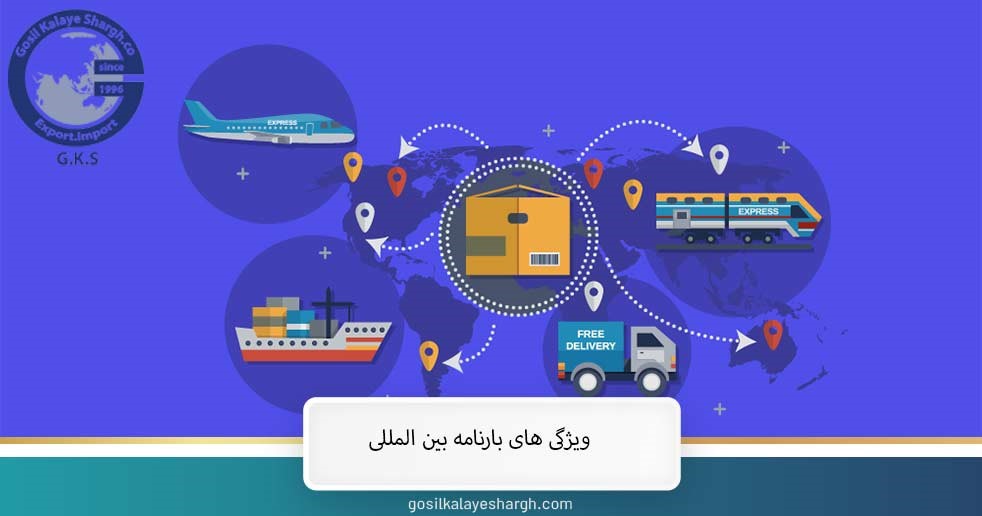Important information is written on this document, therefore it is one of the three most important documents in international trade. Bills of lading are non-transferable and non-proprietary. From the time this document is issued, the recipient has the opportunity to deliver the cargo to its destination. You can stay with us until the end of the text to learn about the types of bill of lading and its issuing rules.
Components of the bill of lading
All the required specifications are included on the bill of lading, and this document has important components that we will introduce here:
- Serial number
The serial number is a unique number assigned by the transport organization for each consignment note. This two-part number is the distinguishing feature of bills of lading. To learn about this serial number in international transportation, you can read the related article.
- product receiver
Among the other components of the bill of lading, we can mention the consignee of the goods, which is placed in the upper part and contains all the characteristics of the consignee. The warehouse information related to the recipient must be registered in the comprehensive warehouse system.
- راننده ناوگان
The person responsible for transporting the goods is the fleet driver who has an important duty. He must deliver the goods to the destination without physical damage in the specified time. According to the rules established in goods export company, each driver can only drive 9 hours a day. To get more information about the company and its rules, you can read the article.
- Date and time of issue
The date and time of issue is an inseparable part of the bill of lading, which is also very important. Insurance coverage is applied on the date of registration. For this reason, you must check the date and time recorded when delivering the bill of lading.
- The sender of the goods
In the upper part, the name of the sender of the goods is inserted. It is mandatory to register the sender’s information in complete accuracy. According to the new rules, you need to register the postal code in the comprehensive warehouse system.
- Carrier fleet
The carrier fleet is another part of the cargo that takes responsibility for cargo transportation. The car chosen for this work must be suitable for the type and volume of the load. All vehicle specifications are included in this document. Kalanavgan has the biggest role in clearance, you can get more information by reading this article.
- cargo
The cargo is the goods that are moved according to the bill of lading. All the details of the goods are recorded in the bill of lading right after the driver’s details. Some shipments require a permit and others are transported without a permit.
- Constituent financial items
In this section, information related to financial affairs is included. From the financial items in the bill of lading, we can refer to the insurance cost, freight cost, road tolls, transportation and additional costs, which are calculated accurately.
- Base fare
The basic fare in the bill of lading is mentioned so that the receiver is fully aware of it. The Road Transport Organization determines the minimum fare based on important factors. If the fare is less than the specified amount, the system gives an error.
Types of bills of lading
There are different types of waybills and each one is sent to the destination in a specific way. The transport organization divides them into the following categories based on the way they are sent:
sea bill of lading
This type is considered for goods that are to be shipped to the destination by ship. In this document, in addition to recording the cargo information, information about the ship and the unloading port is also included. This program itself has various examples as follows:
- Group waybill or multiple shipments
- Multimodal bill of lading
- Separation
air bill of lading
This type is widely used for transporting goods. This document is used in cases where the owner of the goods intends to send it by plane. In this bill of lading, it is not possible to change the information after reaching the destination. This bill of lading is not negotiable and is divided into 2 separate categories:
- Master or original bill of lading
- House or subsidiary bill of lading
Rail waybill
A rail bill of lading is issued when you intend to transport goods by rail. In this document, important information such as the appointment number of the wagon is written so that the recipient can easily receive the goods.
Truck bill of lading
Loads that are going to be moved by truck must have this bill of lading. Transportation in this section is done by roads. This method is widely used and is used in most transport companies.
National bill of lading
This is a complete bill of lading and includes all bill of lading samples. This bill of lading is used in situations where the goods are supposed to reach the destination in several ways. The information recorded in this bill of lading is more and includes all the combined methods.
Fiat composite waybill
In this bill of lading, information is entered in more detail and with high sensitivity: because the destination country has many restrictions and sensitivities. One of the important things mentioned in this document is the precise registration of the destination and specifying the vehicle for carrying the cargo. This bill of lading is very important for the passage of valuable and sensitive goods.
Domestic bill of lading
This program is issued for loads that are only moved within the borders and do not need to cross the border. Important information is recorded in this document and it is issued in 6 separate copies.
International bill of lading
According to this bill of lading, loads are sent to other countries, that’s why it is very important and must be based on the rules of international transport convention. All the information entered in this bill of lading must be correct and it must be stamped and approved by the convention.
Types of bill of lading in terms of documents
The bills of lading issued by the transport organization have different examples and are divided into the following categories in terms of documents:
official bill of lading
This bill of lading has a legal license and is issued by the shipping company. You can see all the components in this bill of lading and it can be cited because it is official.
Unofficial bill of lading
This bill of lading is unofficial and the organization has no role in issuing it; Rather, it is written manually by the seller and the owner of the goods. In this bill of lading, only the origin, destination and fare are mentioned.
Negotiable bill of lading
This bill of lading is negotiable and you can deliver the goods to anyone who has this original copy. The buyer and consignee or its representative must prepare this original copy for delivery.
Non-negotiable bill of lading
In this bill of lading, the name of the recipient must be specified, otherwise the goods will not be delivered to the recipient. Buyers can claim and release the shipment only by verifying the identity.
Conditional or clean bill of lading
According to this bill of lading, you can check the health of the goods inside the ship. When the quality of the cargo reached the destination is confirmed, the bill of lading is signed by the sender. With this important document many times they are protected from harm.
Unconditional or dirty bill of lading
This bill of lading has various clauses and it proves that the packaged product has reached the destination with damage. In the table below, we state the difference between conditional and unconditional bill of lading:
|
conditional bill of lading |
Unconditional bill of lading |
|
This document is not accepted by importers and banks. |
It is a sea shipping document that importers endorse. |
|
Contains an additional clause with the standard Transport Board symbol. |
It is marked with a standard symbol. |
|
Clearly indicates that the item is not in the expected condition.
|
It shows that the product has high-quality packaging and reaches its destination in the best conditions. |
direct bill of lading
Another name of this document is the cargo bill of lading, which is considered non-negotiable. In this bill of lading, you can deliver the goods to him at the destination by presenting the recipient’s identity, and there is no need to pay.
Transhipment bill of lading
This bill of lading is used in situations where the shipping company does not provide any services at the place of the sender and receiver. At this time, the cargo is sent from the middle port and all costs are paid by the ship owner.
Original bill of lading or master
This bill of lading is issued by the carrier and it is possible to print it in different versions. If the intermediary company is involved in this transportation, it should be mentioned in the bill of lading.
carrier bill of lading
This bill of lading is negotiable and the goods are delivered to whoever has the bill of lading. The recipient’s name is not specified in this document and it is mostly used for small volume shipments.
Stale bill of lading
This old bill of lading was submitted after the mentioned deadline and is not valid. If the owner of the goods has such a document, he cannot send the cargo to the destination with it; Because it is not valid.
Switch bill of lading
The switch bill of lading replaces the original copy and the carrier is responsible for issuing it. When the goods leave the port of origin, you need to have such a bill of lading.
The importance of the bill of lading
The existence of a bill of lading is important because it is a negotiable document and with its help, goods can be moved in different ways. This document is written unconditionally and with the agreement of the parties. The bill of lading is considered as proof of ownership, that is why it is important in the transport organization. This legally binding document must be sent along with the goods and be available to the recipient.
All the necessary details for processing and checking the shipment are included in the bill of lading. If needed, you can use it in lawsuits. If the goods are damaged during the transportation process, it can only be proven with this important document. With the help of the bill of lading, duties are well separated and this can prevent cargo theft. The shipment in transit can be easily tracked.
bill of lading rules
Domestic and international shipping companies consider different rules and regulations for the senders and receivers to issue the bill of lading, which we mention here:
Laws of bill of lading issuers
Transport companies are required by law to issue a bill of lading with liability insurance. Insurance should cover all risks well. All the contents of the bill of lading must be prepared and completed, and the freight rate must be recorded in it according to the contract. Issue a transit permit for traffic loads. The bill of lading should be issued from the legal origin of the company to other places.
Bill of Lading Consignor Rules
The senders of the bill of lading must declare the details of the cargo and the exact and correct address. The details of the receiver and the correct place of unloading must be correctly written in the bill of lading, and all the information of the goods, including length, width, height, and weight, must be declared. The timely loading of the fleet and its dispatch in order to prevent possible damages are considered as part of the shipper’s rules.
Rulers
The most important rule for consignees is timely unloading of the fleet in order to avoid the payment of demurrage. The fare listed in the bill of lading must be paid in full.
Law of drivers
The driver is obliged to deliver the cargo to the destination without damage. Being on time during loading is one of the important criteria in the transportation organization. It is mandatory to keep the bill of lading issued in order to collect the freight at the destination and to be present during the unloading of the cargo at the destination.
Classification of bill of lading
The bills of lading issued by the transport organization are generally of 2 categories:
Domestic bills of lading
Nowadays, these bills of lading are issued electronically, and according to them, the owner of the goods is allowed to move the cargo inside the border. If the goods are sent outside the border, there will be a heavy fine.
Foreign and international bills of lading
In the classifications made, international or foreign bills of lading are more sensitive; Because they have to enter another country with more restrictions. These important and confidential documents are moved along with the shipment to be available to the recipient.
Features of international bill of lading
International bills of lading have features that you do not see in other bills of lading. These documents are very important and their level of sensitivity is high. An international bill of lading is a contract of carriage in which the duties of the carrier and the holder of the bill of lading are specified, and this can prevent damage to the cargo.
Another feature of this bill of lading is the right of ownership and possession of the goods. This important receipt is received for the goods and can include insurance. The way to pay the fare is specified in it, and in this case the recipient cannot increase or decrease it. The bill of lading proves that the shipper has delivered the goods to the carrier. The international bill of lading is a negotiable and unconditional document.
Terminal fee and how to calculate it
Terminal fee is the freight commission fee that the shipping company receives according to the issued bill of lading. All shipping companies charge a fee for their services. The volume of the cargo, the type of goods and the distance traveled are among the most important factors affecting the right of the terminal. The greater the volume of cargo and the greater the distance traveled, the higher the cost of transportation will be.
This fee is a percentage of the value of the shipment or a fixed amount. If 8 to 10 percent is calculated, the cargo owner must pay 8 to 10 percent of the total cargo amount as terminal fee. For calculation, the parties must agree. The commission fee registered in the bill of lading is the sum of the road tolls and the organization fee. The commission fee varies in public terminals and outside of it. The cargo owners have to pay this approved rate according to the law.
Cargo insurance and how to calculate it
Cargo insurance is one of the most important components of transporting a commodity, which is calculated as a percentage and according to the value of the cargo. Cargo insurance is very important in the transportation system, that’s why all bills of lading are issued with a valid insurance policy. When the shipments are moved with liability insurance coverage, if there is damage to them, the insurance will pay for this damage.
Transport companies mostly use civil liability insurance. The cost of cargo insurance is calculated based on the value of the cargo. The insurance company has a special tariff and calculates the insurance of each shipment based on that. The higher the value of the cargo, the higher the insurance. If the cargo worth 100 million is transported, you have to pay 10 thousand tomans to insure it.
bill of lading fee
The cost of the bill of lading is determined based on important factors such as the type of loading, the amount of cargo, the city of origin, the value and volume of the cargo. The further the distance from the city of origin, the higher the cost of moving. Goods that are sent abroad are much more expensive to transport. The shipping method can also affect the cost.
Shipments that are moved by air will cost more. Valuable goods are always shipped at a high cost. The transport organization has its own rules and regulations for calculating the final cost. If the load is more than the capacity according to the ton/km note, the extra load fee will be calculated separately.
final word
A bill of lading is an important document that all shipping companies need to move cargo. In this document, all the information of the recipient, the sender and the shipment are recorded. There are different types of bills of lading and they are classified according to the method of shipment. For the safety of the goods, the existence of the bill of lading is important, that’s why we provide you with the conditions for receiving official and legal bills of lading on the Ghasil Kala Shargh site. Our experts pave the way for applicants to receive the bill of lading with their guidance.







